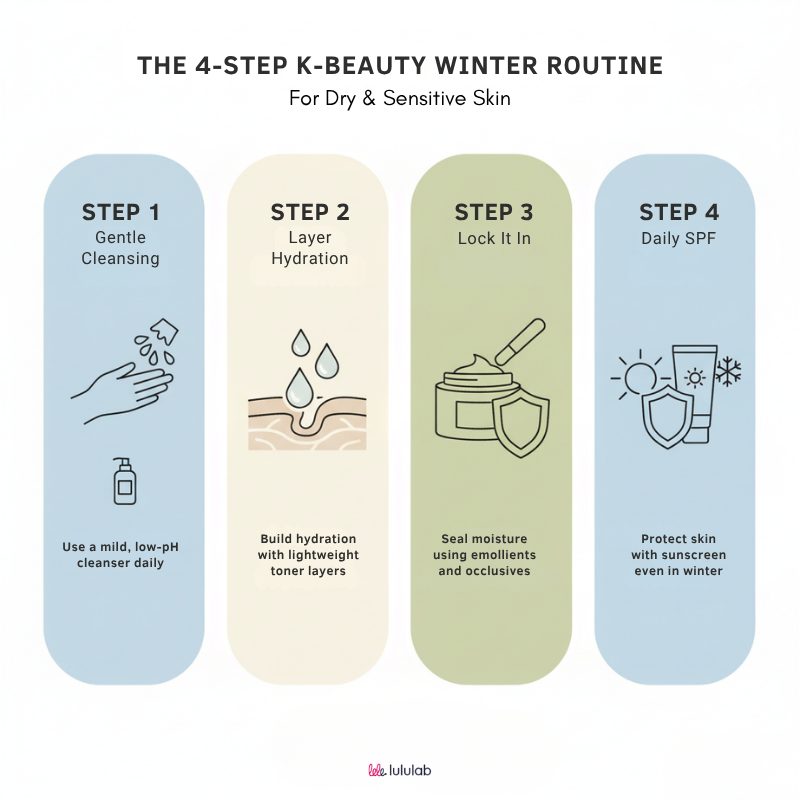
Winter Skin Care Routines You’ll Actually Look Forward To
That tight, itchy feeling you get in the colder months is more than just seasonal discomfort. It is your skin’s way of telling you that its protective barrier is struggling. Cold winds, indoor heating, and the lack of moisture in the air strip away hydration, leaving skin feeling vulnerable and irritated. For those with dry or sensitive skin, this can feel never-ending.
The good news is there are gentle, effective ways to restore comfort and resilience. Korean skincare principles, rooted in layering lightweight hydration and barrier support, offer a practical and soothing approach. In this guide, we will explore how to protect your skin, maintain hydration, and keep sensitivity at bay so you can enjoy winter without the stress of dryness.
Why Winter Makes Your Skin Feel So Uncomfortable
Cold air outside, heated rooms inside, and frequent temperature changes all lead to one outcome: moisture escaping from your skin. This process is called transepidermal water loss (TEWL,) and it’s the main reason your skin feels rough, tight or flaky in winter. Without enough hydratio,n your skin becomes more reactive and less able to defend itself from irritation.
The Crucial Role of Your Skin Barrier in Winter
Think of your skin barrier as a brick wall. The bricks are your skin cells, and the mortar is made of ceramides, fatty acids, and cholesterol. Together, they act as a shield that locks in moisture and protects against irritants. During cold winter weather, this mortar weakens, allowing hydration to escape and leaving you with dry skin. A compromised barrier also struggles to shed dead skin cells, which can lead to rough texture and sensitivity.
That is why barrier-repairing ingredients are vital in your winter skin care routine.
→ Ceramides: restore the “mortar”
→ Fatty acids: keep skin flexible
→ Cholesterol: strengthens resilience
When replenished, these elements help your skin retain moisture, feel calmer, and stay healthier all season.
The Ultimate Korean Winter Skincare Guide for Dry, Sensitive Skin
Step 1: Gentle Cleansing
A good winter skin care regimen starts with the right cleanser. Harsh foaming cleansers, rough scrubbing, and hot water can strip away the natural oils, leaving skin feeling dry. Even long bath time sessions with very warm water can weaken your barrier further. Instead, choose a low-pH (mildly acidic), gentle cleanser that clears away impurities without disrupting hydration. Using a pH-balanced cleanser helps you maintain soft, hydrated skin while reducing irritation, as it aligns better with the skin's natural, slightly acidic barrier.
Look for soothing ingredients:
→ Snail Mucin
→ Centella Asiatica (Cica)
→ Oat extracts
Cleansing should feel refreshing, not drying. When done correctly, this step sets the foundation for healthy, resilient skin throughout the winter.
Step 2: How to Layer Hydration the Korean Way
The Korean layering method is all about building hydration gradually. Instead of one heavy application, you apply lightweight toners in two to three thin layers. This is often enough to keep your skin hydrated without feeling heavy. Always start with the thinnest texture and work your way up, giving each layer time to absorb before the next.
Focus on humectants, which draw water into the skin:
→ Hyaluronic Acid: plumps and holds moisture
→ Glycerin: attracts and retains hydration
→ Beta-Glucan: soothes and relieves flakiness
For best results, apply these to slightly damp skin right after cleansing. Then follow with a serum for deeper hydration, and finish with a nourishing cream to lock everything in.
Do not forget your lips and hands.
Both are especially prone to dryness in winter. Keep your lips soft with a hydrating lip balm or by layering a thin coat of petroleum jelly to seal in moisture and prevent dry lips. For your hands, apply a rich hand cream regularly, especially after washing, to keep them protected and comfortable in harsh winter conditions.
If you are looking for targeted product suggestions for your dry winter skin, explore our guide to the best Korean serums for every skin concern. It will help you choose the right skin care products and ingredients, making your winter skin care routine more effective and soothing.
Step 3: Locking It All In for Lasting Comfort
Once hydration is in place, you need to protect it. This is where emollients and occlusives come in. Emollients like shea butter and squalane smooth rough skin texture while occlusives like ceramides, petrolatum, and jojoba oil form a protective layer that locks in moisture.
For winter dryness, choose a moisturizer or cream rich in:
→ Ceramides: rebuild the skin barrier
→ Cholesterol: strengthens resilience
→ Fatty Acids: keep skin soft and flexible
Together, these ingredients repair the barrier, reduce dry patches, and ease sensitivity caused by indoor heating and cold weather.
Apply your moisturizer while skin is still slightly damp.
This helps emollients and occlusives lock in more hydration and keep your skin comfortable for longer. A protective layer of lip balm or petroleum jelly can also keep lips soft and healthy year round.
Step 4: Don’t Skip SPF!
Even in winter weather, UV rays can still wreak havoc on sensitive skin. In fact, the winter sun combined with snow reflection can increase exposure. This leads to inflammation, irritation, and long-term skin conditions like eczema or keratosis pilaris.
For daily protection, use a sunscreen formulated for dry winter skin. Mineral options with zinc oxide or titanium dioxide are often gentler and less irritating, making them ideal for sensitive skin. This step helps keep your skin barrier strong and your complexion calm, even in the harshest winter months.

Daily Habits to Keep Your Dry Winter Skin Comfortable All Season
1. Use a Humidifier
Indoor heating dries out the air and worsens winter skin issues like flakiness and itchiness. A humidifier helps maintain around 60% humidity, keeping skin naturally hydrated and more comfortable. This simple change reduces sensitivity and prevents dryness from becoming severe during cold months.
2. Diet and Hydration
Skin health starts inside. Drink enough water daily and eat Omega-3-rich foods such as salmon, walnuts, and avocados. These healthy fats strengthen the skin barrier, improve texture, and lock in hydration. Pairing good nutrition with a consistent skincare routine keeps skin nourished from within.
3. Avoid Hot Showers
Hot showers may feel soothing, but they strip natural oils and worsen dryness. Choose lukewarm water instead and keep showers to 10–15 minutes. Always follow with a moisturizer or body lotion after towel-drying to seal in hydration and protect against winter discomfort.
Your Skin Can Thrive This Winter
Winter weather does not have to mean flaky skin or constant discomfort. The key is to stay consistent with your skincare routine and give your skin the extra attention it needs during colder months. Even small adjustments, such as lowering your shower temperature, using a humidifier, or remembering sunscreen on a snowy day, can make a big difference. With the right care, you can keep your skin smooth and comfortable season-long and truly winter-proof your routine.
Healthy skin is not just for winter. These habits also benefit your skin in summer and beyond, keeping it resilient throughout the year.
Still not sure?
If you are still unsure what your skin really needs this winter, try our quick AI skin test. It will help you understand your skin type better and guide you toward solutions that keep it healthy and comfortable.
FAQs
1. Is it okay to use an oil-based cleanser in the morning instead of just water?
Yes, this is a great idea for dry skin! A gentle oil or balm cleanser removes light residue without stripping your natural oils, unlike harsh foaming cleansers. This keeps your skin feeling clean, comfortable, and conditioned, providing a "clean" feel without the tight, dry sensation.
2. How can I tell the difference between "purging" and a product causing a "breakout" in winter?
Purging is temporary and occurs only with cell-turnover boosters (like retinoids) in areas where you usually break out. A winter breakout/irritation is often red, itchy, and may appear in new areas due to a compromised barrier. Stop the product and focus on soothing ingredients if irritation occurs.
3. My moisturizer isn't working—I still feel dry an hour later. Should I just use a thicker cream?
No. You likely need to add more hydration (humectants) before the cream. Apply a lightweight toner or essence (Hyaluronic Acid, Glycerin) to damp skin after cleansing. The moisturizer then locks that water in.
4. My skin is getting red and flaky around my nose/mouth. Is this just dry skin or something else?
This persistent redness and flakiness can be a sign of perioral dermatitis or eczema, often triggered by cold weather and a weakened barrier. Stop all active ingredients in the area. Simplify your routine to a gentle cleanser and a Ceramide-rich cream. If it doesn't improve, see a dermatologist.
5. Can I still use my exfoliating serums (AHAs/BHAs) in the winter? I'm worried they will make my dry skin worse.
Reduce exfoliation to once or twice a week at most. Winter skin is more vulnerable, and strong exfoliants are stripping it. If you have sensitive or dry skin, consider switching to a gentler acid like PHA instead. Always listen to your skin and focus on barrier repair if you feel any stinging or tightness.

